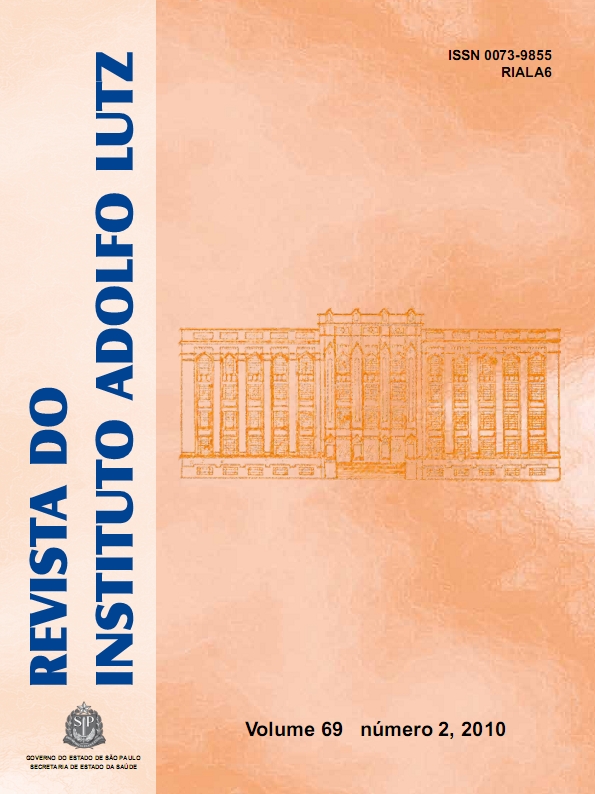Resumo
A nefropatia diabética (ND) é uma complicação comum do diabetes mellitus (DM), sendo que a
hiperglicemia está associada ao desenvolvimento das lesões glomerulares observadas na ND. Neste estudo
foram avaliados os níveis de HbA1c em pacientes diabéticos com e sem nefropatia. Foram determinados os
níveis de glicose, colesterol total, HDL-colesterol, LDL-colesterol, triglicérides, creatinina, taxa de filtração
glomerular (TFG), HbA1c e microalbuminúria em pacientes diabéticos tipo 2 sem nefropatia (n=50) e
com nefropatia (n=57). Os valores de HbA1c nos pacientes dos grupos sem nefropatia e com nefropatia
foram, respectivamente, de 6,4 ± 0,1% e 7,0 ± 0,1%. O grupo de pacientes com nefropatia apresentou
níveis mais elevados de microalbuminúria do que o grupo sem nefropatia (62,7 ± 7,3 mg/L versus 7,4
± 0,7 mg/L, P<0,001), e a TFG obtida no grupo com nefropatia foi significativamente menor do que a
observada no grupo sem nefropatia (67,9 ± 2,5 mL/min/1,73 m2 77,4 ± 2,3 mL/min/1,73 m2, 0,01). Não
foram observadas diferenças significativas entre os grupos quanto aos níveis de glicose e perfil lipídico. Os
valores de hemoglobina glicada foram mais elevados nos pacientes com nefropatia, o que evidencia o papel
deste marcador no controle do diabetes e na prevenção de risco para o desenvolvimento das complicações
crônicas da doença.
Referências
1. Diretrizes da Sociedade Brasileira de Diabetes. [acesso 2008 dez 13]. Disponível em: [http://www.diabetes.org.br].
2. Indicadores e Dados Básicos - Brasil - 2007. [acesso 2009 mar 25] Disponível em: [http://www.datasus.gov.br].
3. Malerbi D, Franco LJ. The Brazilian Cooperative Group on the Study of Diabetes Prevalence. Multicenter Study of the Prevalence of Diabetes Mellitus and Impaired Glucose Tolerance in the urban Brazilian population aged 30-69 years. Diabetes Care. 1992;15:1509-16.
4. Nathan DM, Meigs J, Singer DE. The epidemiology of cardiovascular disease in type 2 diabetes mellitus: how sweet it is ...or is it? Lancet. 1997;350 (Suppl 1):4-9.
5. Kaefer M, Piva SJ, De Carvalho JAM, Da Silva DB, Becker AM, Coelho AC et al. Association between ischemia modified albumin, inflammation and hyperglycemia in type 2 diabetes mellitus. Clin Biochem. 2010;43:450-4.
6. Burtis CA, Ashwood ER. Fundamentos de Química Clínica. 4 ed. Guanabara Koogan (Rio de Janeiro); 1998.
7. Diabetes Control and Complications Trial Research Group. The effect of intensive treatment of diabetes on the development and progression of long-term complications in insulin-dependent diabetes mellitus. N Engl J Med. 1993;329:977-86.
8. Diabetes Control and Complications Trial Research Group. The relationship of glycemic exposure (HbA sub 1c) to the risk of development and progression of retinopathy in the diabetes control and complications trial. Diabetes. 1995;44:968-83.
9. UK Prospective Diabetes Study Group. Intensive bloodglucose control with sulphonylureas or insulin compared with conventional treatment and risk of complications in patients with type 2 diabetes. Lancet. 1998;352:837-53.
10. American Diabetes Association. Standards of Medical Care in Diabetes-2010. Diabetes Care. 2010;33:S11-61.
11. Valmadrid CT, Klein R, Moss SE, Klein BE. The risk of cardiovascular disease mortality associated with microalbuminuria and gross proteinuria in persons with older-onset diabetes mellitus. Arch Intern Med. 2000;160:1093-1100.
12. Gross JL, Bruno RM. Prognostic factors in Brazilian diabetic patients starting dialysis: a 3.6-year follow-up study. J Diabetes Complications. 2000;14:226-71.
13. Murussi M, Murussi N, Campagnolo N, Silveiro SP. Early detection of diabetic nephropathy. Arq Bras Endocrinol Metabol. 2008;52:442-51.
14. Piccirillo LJ, Gonçalves MF, Clemente EL, Gomes MB. Markers of inflammation in type 1 diabetic patients. Arq Bras Endocrinol Metabol. 2004;48:253-60.
15. Gross JL, Silveiro SP, Canani LH, Friedman R, Leitão CB, De Azevedo MJ. Nefropatia diabética e doença cardíaca. Arq Bras Endocrinol. 2007;51:244-56.
16. Friedewald WT, Levy RI, Fredrickson DS. Estimation of the concentration of low-density lipoprotein cholesterol in plasma, without use of the preparative ultracentrifuge. Clin Chem. 1972;18:499-02.
17. Levey AS, Coresh J, Greene T, Marsh J, Stevens LA, Kusek JW et al. Expressing the Modification of Diet in Renal Disease Study equation for estimating glomerular filtration rate with standardized serum creatinine values. Clin Chem. 2007;53:766-72.
18. Mattock MB, Morrish NJ, Viberti G, Keen H, Fitzgerald AP, Jackson G. Prospective study of microalbuminuria as predictor of mortality in NIDDM. Diabetes. 1992;41:736-41.
19. Hovind P, Tarnow L, Rossing P, Jensen BR, Graae M, Torp I et al. Predictors for the development of microalbuminuria and macroalbuminuria in patients with type 1 diabetes: inception cohort study. Brit Med J. 2004;328:1105-08.
20. Dahlquist G, Stattin EL, Rudberg S. Urinary albumin excretion rate and glomerular filtration rate in the prediction of diabetic nephropathy; a long-term follow-up study of childhood onset type-1 diabetic patients. Nephrol Dial Transplant. 2001;16:1382-6.
21. Caramori ML, Fioretto P, Mauer M. The need for early predictors of diabetic nephropathy risk: is albumin excretion rate sufficient? Diabetes. 2000;49:1399-408.
22. Tryggvason G, Indridason OS, Thorsson AV, Hreidarsson AB, Palsson R. Unchanged incidence of diabetic nephropathy in Type 1 diabetes: a nation-wide study in Iceland. Diabetic Med. 2005;22:182-7.
23. Svensson M, Sundkvist G, Arnqvist HJ, Björk E, Blohmé G, Bolinder J et al. Signs of nephropathy may occur early in young adults with diabetes despite modern diabetes management: results from the nationwide population-based Diabetes Incidence Study in Sweden (DISS). Diabetes Care. 2003;26:2903-09.
24. Stratton IM, Adler AI, Neil HA, Matthews DR, Manley SE, Cull CA et al. Association of glycaemia with macrovascular and microvascular complications of type 2 diabetes (UKPDS 35): prospective observational study. Brit Med J. 2000;321:405-12.
25. Libby P. Changing concepts of atherogenesis. J Int Med. 2000;247:349-58.
26. Muhlestein JB, May HT, Jensen JR, Horne BD, Lanman RB, Lavasani F et al. The reduction of inflammatory biomarkers by statin, fibrate, and combination therapy among diabetic patients with mixed dyslipidemia: the DIACOR (Diabetes and Combined Lipid Therapy Regimen) study. J Am Coll Cardiol. 2006;48:396-01.

Este trabalho está licenciado sob uma licença Creative Commons Attribution 4.0 International License.
Copyright (c) 2010 Francielen Anversa Dimer, Ana Cláudia Cirne Berndt, Sílvia Juliane Piva, rafael Noal Moresco
